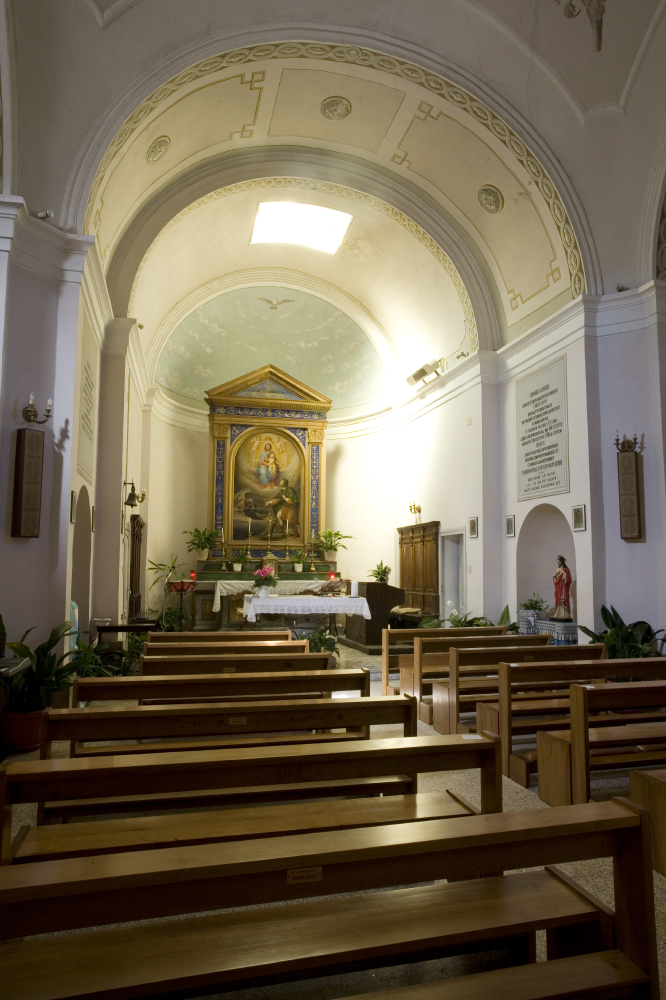- admin
- Nov, 09, 2024
- Places to visit
- Commenti disabilitati su 14. Church of San Rocco


On the lakeside avenue, Viale Regina Margherita, stands the small church dedicated to Capodimonte’s patron saint, San Rocco, a pilgrim of the Via Francigena. His feast is celebrated on August 15 and 16 with a traditional religious procession and a renowned fireworks display on Ferragosto night.
San Rocco is one of the most popular healing saints in the West; between the Middle Ages and the 19th century, he was invoked to ward off outbreaks of plague. He is typically depicted as a pilgrim with a staff, cloak, satchel, and sandals, walking despite a plague sore on his leg, accompanied by a dog—his only companion. Born in Montpellier, France, between 1345 and 1350, San Rocco came from a wealthy merchant family. After the death of his parents, he donated all his riches to the poor and set out for Rome along the Via Francigena, where he cared for many plague victims along the way and performed miraculous healings. After contracting the plague himself, he took refuge in a cave where a dog brought him a piece of bread every day, saving his life.
The people of Capodimonte dedicated this church to him for his intercession during the cholera epidemic of 1837 that devastated the province and severely affected the nearby town of Marta. The population of Capodimonte was miraculously spared from this calamity and made a vow to San Rocco to build a church in his honor. In 1838, everyone contributed to its construction both financially and through manual labor. Materials were transported by fishermen using their boats from the ruins of the ancient Castle of Bisenzio. An important donation was also made by Cardinal Vincenzo Macchi.
An inscription on the facade commemorates the circumstances surrounding the church’s construction: “PRO PERICVLO VOVIMVS – PRO GRATIA FECIMVS” (“We made a vow for our peril; we built for the grace received”). This small church not only serves as a place of worship but also stands as a testament to community resilience and faith during times of crisis.
The church, built in the shape of a Greek cross, houses a remarkable altarpiece depicting the Madonna with Child, San Rocco, and Saint Michael the Archangel. This work was created free of charge in 1855 by the painter Luigi Cochetti, an academic of San Luca in Rome. Cochetti frequently stayed in Capodimonte and on Bisentina Island, and he also decorated several rooms in Villa Torlonia in Rome and the “Sala del Trono” at the Quirinale. Additionally, he produced numerous sacred works for important churches in the capital, including the Basilica of San Paolo, San Andrea della Valle, and Santa Maria in Trastevere.
The altarpiece dedicated to San Rocco is painted in oil using the glazing technique typical of the purist painters of the Roman school. It commemorates the miracle that saved the people of Capodimonte from cholera in 1855. In this painting, San Rocco—possibly a self-portrait of Cochetti himself—is depicted on a rock, gazing towards the Madonna and Child above the town. At his feet lies a dog holding a piece of bread in its mouth. In front of San Rocco, the angel of death sheaths his sword, driving away the plague from above the lake.
Some scholars suggest that San Rocco is portrayed as a pilgrim on a rocky outcrop near the port of San Bernardino at Monte Bisenzio, where pilgrims once embarked from the Via Francigena to reach Bisentina Island. The background features Viale dei Pioppi with a votive chapel and a small boat on the lake containing several figures, including a religious figure with arms raised to heaven in prayer.
It is possible that some tempera paintings executed at the Quirinale during a wedding in the mid-19th century were also created by Luigi Cochetti.
The two side altars of the Church of San Rocco are dedicated to Saint Vincent Ferrer and Our Lady of Sorrows, respectively. Additionally, there are several tombs belonging to the Brenciaglia family within the church.
Recently, the exterior facade of the church has been enhanced by frescoes created by the German painter Martin Figura. On either side, the patrons and protectors Saint Sebastian and Saint Rocco are depicted, while in the tympanum, Christ Pantocrator is portrayed holding the world in His hand. Above the portal, in the lunette, there is an image of Our Lady of the Cherry Tree with Child.